6 Days Exploration of Eastern Korea




This tour begins on Jeju island and ends upon your arrival in Seoul. Jeju Island is a volcanic island and its lava tubes have been registered by UNESCO as a natural World Heritage Site. On Jeju Island scenic beaches, waterfalls, cliffs and caves lie in harmony with each other and together with the mild weather make this beautiful island an ideal tourist spot. The southeastern part of Korea is rich with tourist attractions. The major sites of this area, which once were ruled by the great ancient Silla Kingdom (57 BC - 935 AD), are Gyeongju, Busan and Andong. Historical sites and colorful scenes of daily life are seen in the small coastal towns as well as deep within the forested mountains of the region. The beaches located along the East Sea coastline provide a variety of recreational water sport opportunities such as boating, fishing and rafting, while the mountains have many well-reputed ski resorts of international standards.
* Minimum 2 persons are guaranteed to depart every Sunday.

Day 1
Jeju Volcanic Island
 You will arrive at Jeju Island, where you will be met by your tour guide. The first stop on today’s tour is Yongduam Rock, a rock formation that resembles a dragon head with an open mouth soaring 100m above sea level, creating harmony with the deep violet-blue sea. Next you will trek the Orum, a parasitic volcano cone on the top of a mountain where there is a large, deep tunnel-shaped crater (during the winter, you will visit the Natural History Museum instead), Optional tour: Motorbike show where you can see an aerial stunt performance ($10 USD).
You will arrive at Jeju Island, where you will be met by your tour guide. The first stop on today’s tour is Yongduam Rock, a rock formation that resembles a dragon head with an open mouth soaring 100m above sea level, creating harmony with the deep violet-blue sea. Next you will trek the Orum, a parasitic volcano cone on the top of a mountain where there is a large, deep tunnel-shaped crater (during the winter, you will visit the Natural History Museum instead), Optional tour: Motorbike show where you can see an aerial stunt performance ($10 USD).Day 2
Jeju Volcanic Island
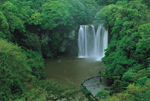
You will begin today's tour by visiting Cheonjiyeon Waterfall, a three-tiered waterfall surrounded by lush foliage and also named the Pond of God. To the east there is a cave where cold water pours from the ceiling to create a waterfall. The water from the first waterfall becomes the second and third waterfalls and then flows into the sea. A legend about seven nymphs and a mountain god is tied to this wondrous place. The next stop is Gyulimseong, a citrus farm and museum with nearly 1000 wild plants and flowers growing in the basalt volcanic rock. Optional tour: A pleasure boat cruise in Seogwipo where you can enjoy the view from both above and below the sea ($12 USD). Many isolated and unexplored regions including islands and Seogwipo’s beautiful coastal scenery are viewed from the boat.

Next you will visit O’Sulloc Tea House, a museum dedicated to green tea. The museum is the shape of a green tea cup, seeking to harmonize the cultures of the West and East and past traditions with the modern world.
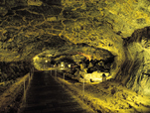
You will continue to Hallim Park where you can explore Palm Tree Road, Jeju Stone and Bonsai Garden, the Water Garden, the Subtropical Botanic Garden and much more. The most famous tourist sites in Hallim Park are Hyeopjaegul and Ssangyonggul, the only two-dimensional caves in the world. In addition, a folk village, children's amusement park and outdoor resort facilities make Hallim Park enjoyable for both children and adults.
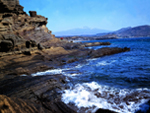
The next place you will visit is Yongmeori (Dragon Head) Shore – an impressive and beautiful oceanside promenade of soaring, weather-blown cliffs. Note that Yongmeori closes during very high seas. If this is the case during your visit, you will visit Sangbanggbulsa, a natural cave overlooking the ocean. Optional tour: Traditional dyeing experience using natural dyes and fibers ($10 USD).
Day 3
Jeju Island > Busan
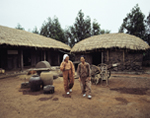
After having breakfast at your hotel, you will check out and begin the day’s tour at Dokkaebi Road (Mysterious Road) – a road on which your vehicle will roll uphill if the vehicle is parked and in neutral. Next you will visit the Amethyst Factory, where you can see and feel excellent quality Korean amethyst stones. You will continue to Seonnyeo (nymph) and Namuggun (woodcutter) Theme Park, comprised of a folk village, old market street, old shanty house village, an agricultural museum displaying old farming utensils and an embroidery museum. Seongeup Folk Village is a wonderful example of Korea’s preserved cultural traditions, including residential houses, Confucian shrine and schools, ancient government offices, stone statues and monuments and fortress ruins. Here you can also experience folk plays, native foods, local craftsmanship and local dialects that have been handed down through generations. When you explore this area, you like you have traveled back in time.

After lunch, you will visit Seongsan Ilchulbong (Sunrise Peak), then transfer to Jeju International Airport and fly to Busan, the 2nd largest city in Korea. After your guide meets you at Gimhae Airport in Busan, you will have dinner and then transfer to your hotel.
Busan Paradise Hotel
Meal:
Breakfast, Lunch
Day 4
Busan > Gyeongju
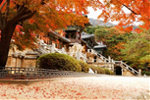
Today you will begin the tour by visiting Yongdusan park, a favorite place for local Busan residents. You will pass by Jagalchi Fish Market, Korea's largest seafood market which was built after the Korean War and which represents the lifestyle of the local people in Busan. Here you can eat fresh raw fish right at the market where all kind of seafood are on display and for sale in ice or in aquariums. Next you will transfer to Gyeongju, one-and-a-half hours drive away. This is the ancient capital city of the Silla Dynasty (57 BC - 935 AD) is really like a museum without walls because of all the historical and cultural heritage sites. Here you will visit Bulguksa Temple built during the most glorious period of the dynasty and is one of the best known temples in Korea. The architectural design of the temple is one of constrained dignity, peace and harmony and the temple still remains as one of the remarkable achievements of the ancient Far East region.

You will continue on to Seokguram Grotto the home of eighth century stone Buddha built during the glorious period of the Silla Dynasty and said to be one of the finest Buddhist shrines in the world. Inside, a serene white statue of a seated Buddha in the sublime state of enlightenment is surrounded by Bodhisattva, disciples and guardians. Both of Bulguksa Temple and Seogulram Grotto are listed as UNESCO World Cultural Heritage Sites.
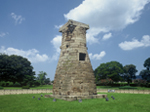
Afterwards, you will visit Gyeongju National Museum, displaying the 23-ton Emille Bell built in 771 AD as well as thousands of priceless treasures. Finally you will transfer to Cheomseongdae, the world's oldest astronomical observatory built during Silla Dynasty.
More Information about Gyeongju
More Information about Gyeongju
Day 5
Gyeongju > Andong > Mountain Seorak

Today you will transfer to Andong, renowned for being the home of the intellectual aristocratic class of Korean society and Confucius scholars during Joseon Dynasty (1392-1910), as well as the birthplace of some of Korea’s cultural traditions including Hahoe masks, Chajeon games and Hahoe spirit rituals. Queen Elizabeth II of Great Britain visited here several
years ago, marking it as a popular international tourist attraction.
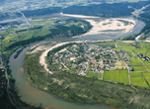
Andong Hahoe Village has preserved its traditional houses and village structure from the Joseon Dynasty. It is a living village, in that a small community of people still live here. Three sides of Hahoe Village are surrounded by the Nakdonggang River, and the village got its name from the way in which the river meanders through it - directly translated, Hahoe means spinning river. Next to Hahoe Village there are many pine trees and a soft sand plain, and across from it is a stunning cliff. After sightseeing at Andong, you will have an opportunity to take an optional tour: an hour-long sea train ride between Samcheok and Gangneung along the East Sea on the way to Mountain Seorak Park ($17 USD; early booking is required).
Day 6
Mountain Seorak National Park > Seoul
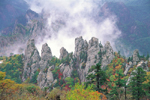
Today you will transfer to Mt. Seorak National Park, designated as a natural monument preservation area and as a Biosphere Preservation District by UNESCO. Seorak means ‘snowy mountain’ in the Korean language, and Mt. Seorak was named so because the snow on its peaks does not melt. The park is spread across four cities and counties: Sokcho, Inje, Goseong and Yangyang. The highest peak is Daecheongbong (1,708m); to the east is OeSeorak (outer Seorak) and to the west is NaeSeorak (inner Seorak), which is divided again into North NaeSeorak and South NaeSeorak. North NaeSeorak is composed of Bukcheon, a stream which flows to Ingyecheon and Baekdamcheon. There are numerous valleys in NaeSeorak. If you follow the Baekdamcheon Valley where all the streams meet, you will reach Baekdamsa Temple.
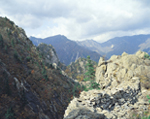
You will have the opportunity to take an optional tour: ride a cable car to Gwongeumseong Fortress, ruins located on the steep stone side of Mountain Seorak ($15 USD). The Fortress is believed to have been built by the 23rd King of the Goryeo Dynasty (918-1392), King Gojong who lived from 1213-1259. At the plateau of Gwongeumseong Fortress you can see the East Sea and the city of Sokcho. Also, to the west, you can see the
fantastic rocks and stones that makes up the Seorak Mountains.
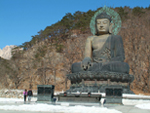
Shinheungsa Temple is a short walk away from the entrance to the fortress. This temple used to be called Hyanseongsa, originally built by Jajangyulsa, who lived from 590 - 658 and who traveled to famous mountains all over the nation during the Silla Dynasty. The temple has been destroyed and rebuilt many times since then. On the path to Shinheungsa, there is a great bronze statue over 10 meters high. Just beyond the statue on a granite terrace, there is a bridge that was recently built for crossing the ravine. Past the bridge there is a long stone wall with a Cheongwang door, and from here you can enter the temple.
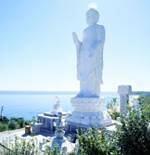
After exploring Mt. Seorak National Park, you will visit Goseong Unification Observatory. This observatory, nearly 700m high, was built by an army unit in 1983 was the closest place from which you could view Mt. Geumgangsan in North Korea before it was opened to South Koreans. Afterwards, you will transfer to Seoul and check in to your hotel.
Meal:
Breakfast, Lunch
* Photos courtesy of Korea Tourism Organization and visitseoul.net.
* The cost of the tour includes: Hotels / Guides / Transportation / Meals (as indicated in the itinerary) / Entrance fees.
* The cost of the tour does not include: International and domestic flights / Travel insurance / Optional tours / Dinner / Tips for the guide and driver ($10 USD per person per day is recommended) / Personal expenses.
Terms and Conditions
- Prices may vary due to availability. We reserve the right to make price adjustments without prior notice.
- Although it is our strong intention to follow the agreed itinerary, there will be a degree of flexibility in consideration of various operational factors including flight delays or bad weather.
- Please refer to our Terms and Conditions before you make your reservation.
- Although it is our strong intention to follow the agreed itinerary, there will be a degree of flexibility in consideration of various operational factors including flight delays or bad weather.
- Please refer to our Terms and Conditions before you make your reservation.

